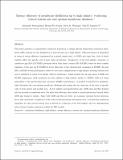Energy efficiency of membrane distillation up to high salinity: Evaluating critical system size and optimal membrane thickness
Author(s)
Swaminathan, Jaichander; Chung, Hyung Won; Warsinger, David Elan Martin; Lienhard, John H.
DownloadLienhard_Energy efficiency.pdf (1.985Mb)
OPEN_ACCESS_POLICY
Open Access Policy
Creative Commons Attribution-Noncommercial-Share Alike
Terms of use
Metadata
Show full item recordAbstract
This study presents a comprehensive analytical framework to design efficient single-stage membrane distillation (MD) systems for the desalination of feed streams up to high salinity. MD performance is quantified in terms of energy efficiency (represented as a gained output ratio, or GOR) and vapor flux, both of which together affect the specific cost of pure water production. Irrespective of the feed salinity, permeate or conductive gap MD (P/CGMD) perform better than direct contact MD (DCMD) wh en the heat transfer resistance of the gap (in P/CGMD) is lower than that of the external heat exchanger in DCMD. Air gap MD's (AGMD) better performance relative to the other configurations at high salinity and large system area can be explained in terms of its thicker ‘effective membrane’, which includes the air-gap region. CGMD and DCMD employing a thick membrane are also resilient to high salinity, similar to AGMD, while not being susceptible to the gap flooding that can harm AGMD's performance. A method is described to simultaneously determine the cost-optimal membrane thickness and system size as a function of the ratio of specific costs of heat energy and module area. At low salinity and small system size, GOR rises and flux declines with an increase in membrane area. For salty feed solutions, there exists a critical system size beyond which GOR also begins to decline. Since both GOR and flux are lower, no economic rationale favors operation above this critical size, irrespective of the costs of thermal energy and system area. A closed-form analytical expression for this critical system area is derived as a function of the feed salinity and two dimensionless ratios of heat transfer resistances within the MD module.
Date issued
2017-11Department
Massachusetts Institute of Technology. Department of Mechanical EngineeringJournal
Applied Energy
Publisher
Elsevier
Citation
Swaminathan, Jaichander et al. “Energy Efficiency of Membrane Distillation up to High Salinity: Evaluating Critical System Size and Optimal Membrane Thickness.” Applied Energy 211 (February 2018): 715–734 © 2017 Elsevier Ltd
Version: Author's final manuscript
ISSN
0306-2619